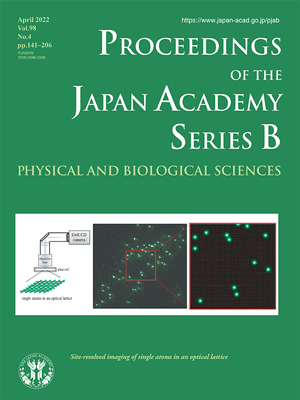About the Cover
Vol. 98 No. 4 (2022)
Almost 40 years ago, Richard Feynman asked himself an important question: “Can quantum systems be probabilistically simulated by a classical computer?”. The answer he found was “certainly, NO!”. Instead, he conceived a novel approach, quantum simulations, for studying complex quantum many-body systems by utilizing another quantum many-body system with high controllability. However, to perform a truly sophisticated quantum simulation study, one needed to wait for technical developments for creating, manipulating, and observing a super-clean, highly controllable quantum many-body system. Such a technical breakthrough was brought about by atomic physicists who successfully created ultracold quantum gases such as a Bose-Einstein condensate and a Fermi-degenerate gas, and load them into an optical lattice, which is an optically produced periodic potential for atoms, just like a crystalline lattice potential for electrons in a solid. In fact, quantum simulation research using ultracold quantum gases in optical lattices has proven to be extremely useful for studying quantum phases and the dynamical evolutions of strongly correlated many-body systems described by a Hubbard model.
In this review article by Takahashi (pp. 141-160) recent developments in this rapidly growing field of ultracold atoms in an optical lattice are described with special focus on work done by using a quantum many-body system of two-electron atoms of ytterbium. On the front cover, single-site resolved imaging of single ytterbium atoms in a Hubbard-regime two-dimensional optical lattice is shown in the middle panel. The right-hand panel shows the reconstructed lattice sites and the distribution of the individual atoms in an optical lattice within the region indicated by the red square in the middle panel. This technique, known as a quantum gas microscopy, was first developed for alkali atoms, which enables one to observe a theoretically predicted antiferromagnetically ordered phase for two-component fermions of alkali atoms. A quantum gas microscope for ytterbium atoms will be a key for revealing the exotic SU(N) quantum magnetism and possible unconventional superfluidity, which will pave the way for our deeper understanding of strongly correlated quantum many-body systems and the possible realization of a novel quantum computation scheme.
Shin Inouye
Professor, Graduate School of Science, Osaka City University




